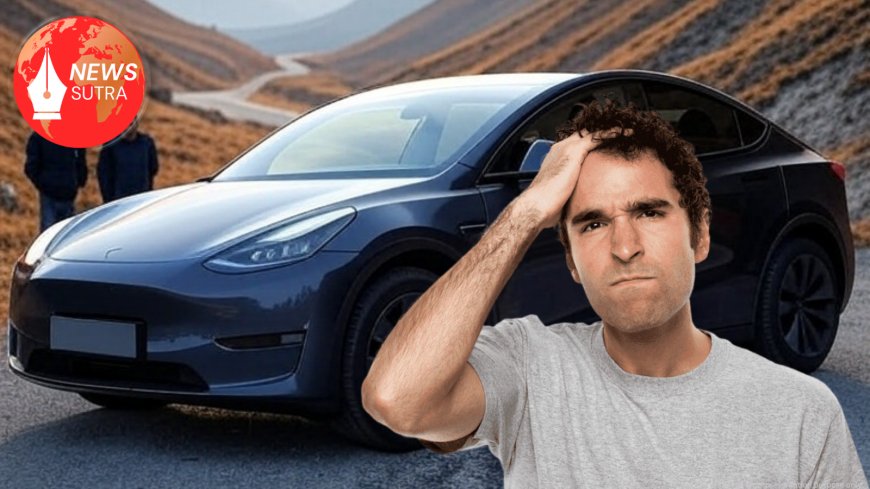Who Really Owns Your Tesla in India? Spoiler: It's Not You — It’s the Government
Wondering why your Tesla costs double in India? Discover the shocking truth behind import duties, taxes, and why the Indian government earns more than Tesla.

When you dream of owning a Tesla in India, you imagine yourself cruising down the highway in a sleek, silent electric marvel, saving the planet and impressing your neighbors. But here’s the twist — while you pay for the car, it’s the Indian government that drives away with the profits.
Yes, you read that right. In the grand scheme of Tesla ownership in India, it feels more like you're just co-sponsoring a government fundraiser — one luxury EV at a time.
Let’s peel back the shiny chrome exterior and dive into the numbers, the humor, and the heavy taxes that make you question: Whose car is it, really?
Tesla in India: Selling Dreams, Not Yet Building Them
As of July 2025, Tesla is not manufacturing in India. Every Model 3, Y, or S that graces Indian roads is a fully imported CBU (Completely Built Unit) — which, in tax lingo, translates to “cash-burning unit” for Indian buyers.
Elon Musk has flirted with Indian soil like a long-distance lover — promises, tweets, and diplomatic dinners. But a factory? Not yet.
Tesla is still testing the waters with imported units while negotiating with multiple state governments to build a Gigafactory, possibly in Gujarat or Maharashtra. Until then, Tesla India is more of a luxury import brand than a local EV revolution.
Who Gets What: The Tesla Price Breakdown (Brace Yourself)
Let’s say you walk into a Tesla experience center (virtually, of course) and order a Model 3 Standard Range Plus. Here’s what your money really pays for:
Model 3 Standard Range Plus
-
Factory Cost (Shanghai): ₹31.6 lakh
-
Shipping & Insurance: ₹1.25 lakh
-
Import Duty (100%): ₹32.85 lakh
-
GST + Cess (28% + 15%): ₹13.2 lakh
-
Total Price (On-Road): ₹79 lakh
-
Tesla’s Profit: ~₹7 lakh
-
Government's Cut: ₹46 lakh
That’s right — for a car that costs around ₹32 lakh to build, you’ll pay ₹79 lakh, and over half goes straight into government coffers. So technically, the Ministry of Finance is your co-driver.
Now let’s look at the bigger boys.
Model Y Long Range AWD
-
Factory Cost: ₹41.5 lakh
-
Shipping: ₹1.66 lakh
-
Import Duty: ₹43.16 lakh
-
GST + Cess: ₹17.5 lakh
-
Final Price: ₹1.03 crore
-
Tesla’s Profit: ~₹9–11 lakh
-
Government’s Share: ~₹60 lakh
Model S Plaid
-
Factory Cost: ₹74.7 lakh
-
Shipping: ₹2.5 lakh
-
Import Duty: ₹77.2 lakh
-
Taxes: ₹30.6 lakh
-
Final Price: ₹1.85 crore
-
Tesla’s Take-Home: ₹12–15 lakh
-
Govt’s Golden Goose: ₹1.08 crore
If this were a group project, the government would be that one kid who didn’t do any work but still got an A+.
Tesla's Profit vs. India's Windfall
Let’s be blunt: Tesla’s earnings in India are modest at best. Their profit per vehicle is around ₹7–15 lakh, while the Indian government makes three to five times more per car.
It’s like Tesla baked the cake, delivered it, served it — and the government took the biggest slice and walked away smiling.
Why Manufacturing in India is Tesla’s Only Way Out
Here’s where the story gets less grim and more optimistic. Tesla is actively negotiating to begin local manufacturing. Once it does, the game changes:
-
No more 100% import duty
-
GST on EVs drops to 5%
-
Eligible for FAME II and PLI incentives
-
Final price slashes by 30–50%
Projected Model 3 (Post-Manufacturing):
-
Local Cost: ₹26 lakh
-
GST (5%): ₹1.3 lakh
-
Final Price: ₹35–40 lakh
-
Govt Revenue: ₹1–2 lakh
-
Tesla Profit: ₹7–10 lakh
See the shift? Suddenly, you get a Tesla at a sane price, and the government only makes enough to cover chai and vada pav.
Why Is the Govt Charging So Much in the First Place?
Great question. The official answer is: “To protect domestic auto manufacturers.”
The unofficial answer? “Because they can.”
Tesla has been lobbying for reduced import duties, suggesting a temporary reduction to 40% for EVs under $40,000. But the government’s response has been cautious — if not ice-cold.
Meanwhile, your dream of a ₹30-lakh Tesla remains a dream.
Is This EV Economics or EV Extortion?
Look, we’re all for taxation — roads, infrastructure, development, etc. But when the tax is higher than the product cost, it starts to feel less like policy and more like legalized daylight robbery with receipts.
If this model continues, Tesla buyers might soon need to crowdfund their own cars. Maybe start a campaign like: “Help me buy a Tesla, and feed a ministry!”
What Tesla Needs to Win in India
-
Gigafactory: A fully operational manufacturing unit in India.
-
Policy Reform: Reduced import duties for initial ramp-up.
-
EV Infrastructure: Fast-charging stations, battery recycling, etc.
-
Localized Supply Chain: Indian auto component players are ready — Tata AutoComp, Sundaram Fasteners, Bharat Forge, and others.
India, with the right strategy, could become Tesla’s next big success story after China.
Conclusion: You Drive the Tesla, The Govt Drives the Earnings
So, to answer the original question:
-
Is Tesla only selling or also manufacturing in India?
→ Only selling, for now. No manufacturing yet. -
Who owns more of your Tesla: you or the government?
→ Definitely the government — at least financially. -
Will this change?
→ If local manufacturing begins and policy shifts, yes. Until then, your ₹1 crore Tesla is just a fancy way to make a personal donation to the Ministry of Finance.


















































